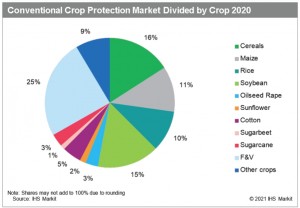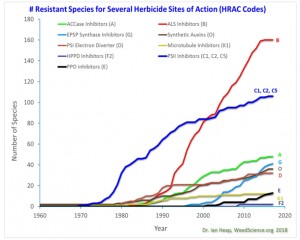In the herbicide market of rice fields in China, quinclorac, bispyribac-sodium, cyhalofop-butyl, penoxsulam, metamifop, etc. have all led the way. However, due to the long-term and extensive use of these products, the problem of drug resistance has become increasingly prominent, and the loss of control rate of once flagship products has increased. The market calls for new alternatives.
This year, under the influence of adverse factors such as high temperature and drought, poor sealing, serious resistance, complex grass morphology, and too old grass, triadimefon stood out, withstood the severe test of the market, and achieved a significant increase in market share.
In the global crop pesticide market in 2020, rice pesticides will account for about 10%, making it the fifth largest crop pesticide market after fruits and vegetables, soybeans, cereals and corn. Among them, the sales volume of herbicides in rice fields was 2.479 billion US dollars, ranking first among the three major categories of pesticides in rice.
According to the prediction of Phillips McDougall, the global sales of rice pesticides will reach 6.799 billion US dollars in 2024, with a compound annual growth rate of 2.2% from 2019 to 2024. Among them, the sales of herbicides in rice fields will reach 2.604 billion US dollars, with a compound annual growth rate of 1.9% from 2019 to 2024.
Due to the long-term, massive and single use of herbicides, the problem of herbicide resistance has become a serious challenge facing the world. Weeds have now developed serious resistance to four types of products (EPSPS inhibitors, ALS inhibitors, ACCase inhibitors, PS Ⅱ inhibitors), especially the ALS inhibitor herbicides (Group B). However, the resistance of HPPD inhibitor herbicides (F2 group) developed slowly, and the resistance risk was low, so it was worth to focus on development and promotion.
In the past 30 years, the number of resistant weed populations in rice fields worldwide has increased dramatically. At present, nearly 80 rice field weed biotypes have developed drug resistance.
“Drug resistance” is a double-edged sword, which not only plagues the effective control of global pests, but also promotes the upgrading of pesticide products. The highly effective prevention and control agents developed for the prominent problem of drug resistance will get huge commercial returns.
Globally, the newly developed herbicides in rice fields include tetflupyrrolimet, dichloroisoxadiazon, cyclopyrinil, lancotrione sodium (HPPD inhibitor), Halauxifen, Triadimefon (HPPD inhibitor), metcamifen (safety agent), dimesulfazet, fenquinolone (HPPD inhibitor), eprifenacil, cyclopyrimorate, etc. It includes several HPPD inhibitor herbicides, which shows that the research and development of such products is very active. Tetflupyrolimet is classified as a new mechanism of action by HRAC (Group28).
Triadimefon is the fourth HPPD inhibitor compound launched by Qingyuan Nongguan, which breaks through the limitation that this kind of herbicide can only be used for soil treatment in rice fields. It is the first HPPD inhibitor herbicide safely used for post seedling stem and leaf treatment in rice fields to control gramineous weeds in the world.
Triadimefon had higher activity against barnyard grass and rice barnyard grass; Especially, it has excellent control effect on multi resistant barnyard grass and resistant millet; It is safe for rice and suitable for transplanting and direct seeding rice fields.
There was no cross resistance between triadimefon and the herbicides commonly used in rice fields, such as cyhalofop-butyl, penoxsulam and quinclorac; It can effectively control barnyardgrass weeds that are resistant to ALS inhibitors and ACCase inhibitors in rice fields, and euphorbia seeds that are resistant to ACCase inhibitors.
Post time: Nov-11-2022






